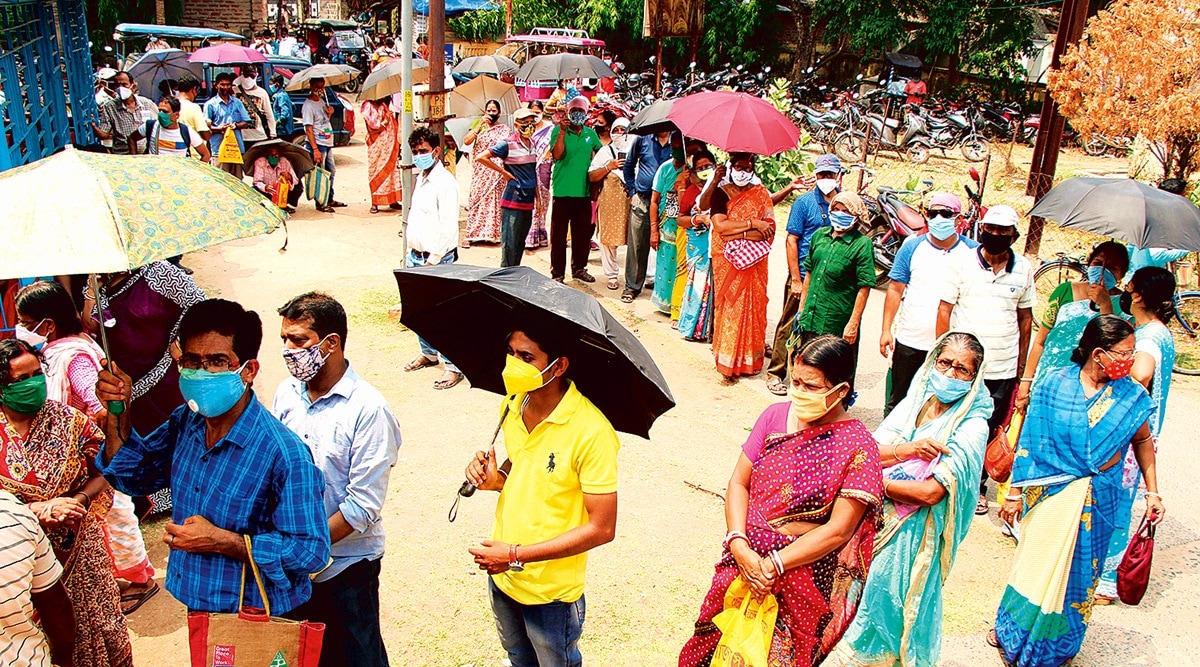 People queue up for hours outside the Bolpur Primary Health Centre in Birbhum for a dose of the vaccine. (Express photo)
People queue up for hours outside the Bolpur Primary Health Centre in Birbhum for a dose of the vaccine. (Express photo) Around 10 am on April 28, a truck full of oxygen cylinders drives in through the gates of Glocal Hospital, a dedicated Covid-19 facility in Bolpur town.
Unlike Delhi and Mumbai, cities that have witnessed a scramble for oxygen, Bolpur — and much of Bengal — haven’t faced a problem of supply yet since the nearest oxygen plant is at Suri in Birbhum. Besides, oxygen also comes from an oxygen plant in Durgapur in West Burdwan district.
But amid a steadily climbing second Covid graph, there are other concerns building up, beginning with a shortage of hospital beds and healthcare professionals.
The 80-bed hospital — set up last year as the first dedicated Covid-19 facility in all of Birbhum — already has 90 patients, including several in the Critical Care Unit. There are eight doctors working round the clock, along with 40 nurses.
“Our doctors and nurses have been getting the infection despite being vaccinated. I don’t know if I will get a bed for myself here if I get infected,” said Assistant Chief Medical Officer of Health (CMOH) of Bolpur Sub-division, Asish Mondal, who is now in charge of the Glocal Hospital.
Bolpur, a Tier 3 town in West Bengal’s Birbhum district, is over 160 km from Kolkata. In 2020, as cases began climbing, the state government converted Glocal Hospital, the biggest in the town, into a dedicated Covid facility.
While Glocal is the only Covid facility, Bolpur has several other hospitals, including the 125-bed Bolpur Subdivisional Hospital, the 50-bed Pearson Memorial Hospital and the 60-bed Bolpur Block PHC, which have been taking in Covid patients in small numbers.
Mondal says that while there is no shortage of oxygen, finding cylinders has been a challenge.
With Birbhum sharing a border with Jharkhand, Mondal says about 10 to 15 per cent of the patients are from the neighbouring state. “We also get patients from every corner of this district. We are doing our best to ensure that they get all facilities,” said the doctor, adding that if patient numbers rose any further, they would have to referred to other hospitals.
The numbers, say health officials, will also depend on how the vaccination drive pans out. So far, Bolpur town, which has a population of 80,210 (as per the 2011 Census) has been carrying out vaccinations for about 400 people on a daily average at two vaccination centres — the Bolpur Sub-divisional Hospital and Bolpur PHC.
About 4 km from Glocal Hospital, outside the Bolpur Primary Health Centre, is a queue of around 300 people, some waiting since 5 am for a dose of the vaccine.
“Please put my name on the list. I have been standing here since early morning,” said a woman in her fifties, mistaking this correspondent for a health official.
Kalyan Sarkar, 62, who is here for his first dose, says, “There is no clarity on when we will get the vaccine. No one gives out any information. We heard that 200 people got vaccines yesterday so we have come today.”
A little after 10 am, a door is opened and around 50 people are taken inside for vaccination.
At the Bolpur Sub-divisional Hospital, Hospital Superintendent Buddhadev Murmu said, “On an average, we have been vaccinating 150 people per day. We have also been conducting 175 to 200 tests a day.”
Himadri Kumar Ari, Birbhum District CMOH and the nodal person handling Covid-19 matters in the district, said the district administration is ensuring that hospitals do not run out of oxygen in times of crisis.
“We have got hold of a large oxygen cylinders. The supply of oxygen is stable. We need the cooperation of all people to tide over this crisis,” he said, adding that the state government has announced that an oxygen plant will be set up at the Bolpur Sub-divisional Hospital.
- The Indian Express website has been rated GREEN for its credibility and trustworthiness by Newsguard, a global service that rates news sources for their journalistic standards.

